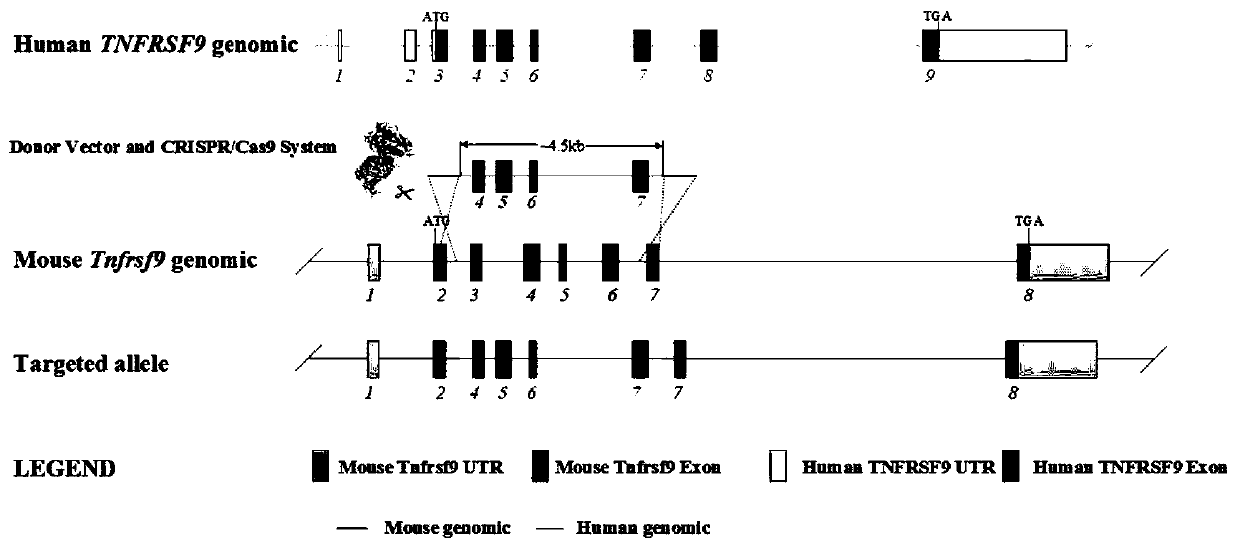Construction method for CD137-gene-modified humanization animal model and application thereof
A construction method and gene modification technology, applied in the field of animal genetic engineering and genetic modification, can solve problems such as hindering clinical development
- Summary
- Abstract
- Description
- Claims
- Application Information
AI Technical Summary
Problems solved by technology
Method used
Image
Examples
Embodiment 1
[0061] Example 1 Construction of CD137 Humanized Targeting Homologous DNA Donor
[0062]In the present invention, after comparing human CD137 and mouse CD137 sequences, the complete extracellular region of human CD137 is selected to replace the complete extracellular sequence of mouse CD137, and the signal peptide, transmembrane region and intracellular region of mouse CD137 are retained. The sequence of the extracellular region of the source CD137 gene is shown in SEQ ID No:1, and the sequence of the extracellular region of the human CD137 gene is shown in SEQ ID No:2. Based on the human BAC (RP11-1080K5) sequence, the CD137 extracellular region sequence was amplified, and the homology arms at both ends of the mouse extracellular region ( SEQ ID No:27 and SEQ ID No:28), were connected with pMD18T to construct a homologous DNA donor, and the full sequence is shown in SEQ ID No:3.
Embodiment 2
[0063] Example 2 CD137 humanized mouse sgRNA screening
[0064] Design sgRNA targeting murine sequence in the humanized replacement region. Design and synthesize the recognition 5' end target site and 3' end target site, and construct sgRNA expression vector. The sgRNA recognition sites at both ends are respectively located at the two ends of the extracellular region of the mouse CD137 gene, and the target site sequences of each sgRNA on CD137 are shown in Table 1. Each sgRNA sequence was cloned into the pUC57kan-T7-delG vector to construct a puc57-sgRNA plasmid) (taking 000060-CD137-5S1 as an example, see SEQ ID No: 8 for the sequence of puc57-sgRNA-5S1).
[0065] Table 1 sgRNA sequence
[0066] sgRNA name
[0067] sgRNA transcription preparation method: use PrimerStar or PrimerStar Max system, sgRNA-F, sgRNA-R as primers, and correctly sequenced puc57-sgRNA plasmid as template to perform PCR, and purify PCR products to prepare sgRNA transcription preparation temp...
Embodiment 3
[0076] Example 3 Establishment of CD137 humanized mouse model
[0077] The sgRNA screened in Example 2 and the CD137 humanized targeting homologous DNA donor designed in Example 1 were injected into 0.5-day-old C57BL / 6 mouse fertilized eggs with the homologous DNA donor and Cas9 / sgRNA system. Transplanted into 0.5-day pseudopregnant female mice, after the mice were born, the target mice (F0) were screened out through genetic identification.
[0078] Genotyping of the F0 generation of humanized mice. Two pairs of primers were used to identify the sequence at both ends of the target in the homologous DNA donor and the sequence in the homologous DNA donor by using two pairs of primers for the obtained mouse tail genomic DNA of the F0 mouse. Primer 000060-huCD137-5'- tF1 / 000060-huCD137-tR1 are respectively located outside the 5' homologous arm and within the human fragment of the homologous DNA donor. If the PCR product is amplified by this pair of primers, it indicates that the ...
PUM
 Login to View More
Login to View More Abstract
Description
Claims
Application Information
 Login to View More
Login to View More - R&D
- Intellectual Property
- Life Sciences
- Materials
- Tech Scout
- Unparalleled Data Quality
- Higher Quality Content
- 60% Fewer Hallucinations
Browse by: Latest US Patents, China's latest patents, Technical Efficacy Thesaurus, Application Domain, Technology Topic, Popular Technical Reports.
© 2025 PatSnap. All rights reserved.Legal|Privacy policy|Modern Slavery Act Transparency Statement|Sitemap|About US| Contact US: help@patsnap.com



